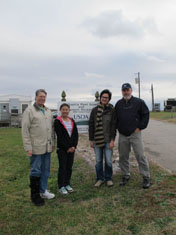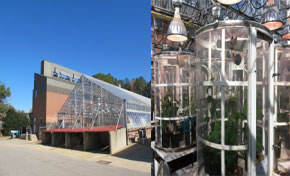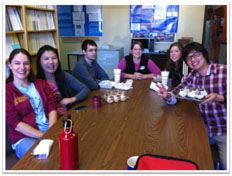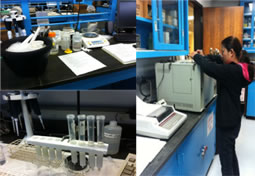Report
Internship: U.S. Department of Agriculture, Agricultural Research Service – The effects of ozone on the biochemical responses of soybeans
 |
 |
 |
| Left to right: Dr. Fitzgerald L. Booker, me, Mr. Prathomrak Na-ngern, and Dr. Kent O. Berkey at the field laboratory | A greenhouse and an open-top chamber for studying the effect of O3 on the biochemical responses of O3-tolerant and O3-sensitive soybeans |
Atmospheric O3 measurement |
 |
 |
 |
| Researchers and graduate students in the research unit | Soybean leaf ascorbate peroxidase and DAF peroxidase enzyme assays and ethylene measurement using the GC system |
Atmospheric H2O2 measurement |
Host: U.S. Department of Agriculture, Agricultural Research Service, Plant Science Research Unit,
Raleigh, North Carolina, USA
Duration: 23 August – 23 November 2011
The effects of ozone on the biochemical responses of soybeans
Cattleya Chutteang ![]()
Department of Symbiotic Science of Environment and Natural Resources
United Graduate School of Agricultural Science
Key words: air pollution, ozone, hydrogen peroxide, biochemical responses, soybeans
1. Activities during the internship
My internship funded by the FOLENS program was carried out from 23 August to 21 November 2010 in cooperation with Dr. Fitzgerald L. Booker and Dr. Kent O. Berkey, Plant Science Research Unit, Agricultural Research Services (ARS), United States Department of Agriculture (USDA), and Department of Crop Science, North Carolina State University (NCSU), Raleigh, North Carolina, USA. Recently, global climate changes and air pollution have been identified as serious global environmental problems; that is, harmful not only to humans but also to natural and agricultural resources. Increasing air pollution, regional changes in temperature, rainfall and light intensity have a tremendous effect on crop growth and can cause severe losses in yields, which may lead to an inability to sustain food production in the future.
Ozone (O3) is a secondary pollutant that has been reaching high concentrations in the Earth’s troposphere. It is considered an important factor among the phytotoxic gaseous air pollutants that may affect crop production and natural resources in the future. Hence the objective of this internship is to study and research the effect of O3 on crop plants. These effects will be elucidated through study in three areas: (1) the effects of O3 on the biochemical responses of O3-tolerant and O3-sensitive soybeans in an attempt to identify tolerant soybean cultivars;
(2) quantification of the concentration of atmospheric O3 and hydrogen peroxide (H2O2) present in observed atmospheric air pollution conditions in Raleigh, NC, USA; and (3) consideration of future environmental issues and agricultural research relating to the environment, particularly air pollution.
In the first month we were introduced to the location and organization of the research unit. There are two research centers: the first comprises a laboratory and greenhouses located on NCSU campus, and the second is a field laboratory located 5 miles from NCSU. The research unit has been conducting research on the effect of O3 on Arabidopsis sp., soybean, snap bean, and barley for several years, ranging from genetic, biochemical, and physiological characteristics to crop yield for crop improvement. I was taught several research techniques in this period, including a gas chromatography technique for ethylene measurement, intercellular infiltration for the histochemical detection of H2O2 and superoxide measurement, and enzyme extraction and analysis for peroxidase measurement. In addition, I was trained in the use of various pieces of equipment, including the LI-6400 portable gas exchange system, spectrophotometer, and milling machine. I was lucky enough to share an office with Dr. Fitzgerald L. Booker and had the opportunity to discuss my research plan with him and other expert scientists. In addition, the tower for monitoring atmospheric O3 and H2O2 was set up in the first week and continued to monitor for four days continuously every two weeks during my internship.
During the second month I worked on my own research, which focused on the effect of O3 on biochemical responses of O3-tolerant and O3-sensitive soybeans. The soybean varieties were provided by Dr. Kent O. Berkey. They were grown in the free-O3 greenhouse for 4 weeks and moved to the growth chambers, which had controlled environments allowing exposure to ambient O3 (10 ppbv) and elevated O3 (70 ppbv). The peroxidase, H2O2, superoxide, and ethylene concentration in the leaves and leaf injury were measured every 2 days after exposure. This experiment was conducted three times.
During the final month I continued to work on peroxidase measurement and was trained in data analysis using both Excel and SAS software. Most of the data were compiled and analyzed during this period. I also visited Raleigh History and Natural Science museums, the botanical gardens, a farmers market, church, natural parks, and lakes in North Carolina to learn about American culture, practice my English and gain other experiences. My extracurricular activities were made possible by the USDA officers and Thai students at NCSU.
2. Experience and achievements of the internship
This internship gave me the opportunity to share and exchange knowledge and ideas about environmental issues with international scientific experts. From these experiences and practices I learnt more about international perspectives and the wider research community. For example, the hot issues in this research unit are crop improvement for food security in the face of future environmental stress such as drought, cold and high temperatures, and air pollution, and research in these areas has been carried out for several years. This may indicate that environmental problems and food security are important issues, both now and in the future, and are closely related. As for the research community in this unit, the researchers and scientists generally co-operated and shared their ideas and knowledge, which made for a good atmosphere for doing research and conducting high-quality research. Moreover, I learnt that considering several points of views, literature reviews, and careful thought are important for conducting research.
In terms of my own project, there were some interesting findings. Our research team found that the sensitive soybean cultivar rapidly responded to elevated O3. High O3 concentration caused high peroxidase, H2O2, superoxide and leaf injury. It can be concluded that peroxidase plays an important role in regulating the H2O2 level and superoxide in plant cells. Increasing H2O2 concentration in the leaf caused cell wall loosening and leaf injury. The research results allowed for a greater understanding of the impact of O3 on crop plants, which will help to identify O3-tolerant plants for crop improvement. The O3 and H2O2 measurements provided information on the phototoxic gaseous pollutants present in Raleigh during late summer. The work itself was interesting and provided me with the opportunity to learn several new techniques, which can be applied in environmental and agricultural science, both in future research and in academic classes. Working on a real topic and learning new techniques was an obstacle, but I learnt a great deal through hard work.
This project and internship would not have been possible without the support of my colleague, Mr. Prathomrak Na-ngern; my supervisor in Japan, Professor Masatoshi Aoki; my supervisor in NC, Dr. Fitzgerald L. Booker, and Dr. Kent O. Berkey and all of their colleagues; Assistant Professor Sachi Ninomiya-Lim; and FOLENS staff. Finally, this internship allowed me to experience being both a leader and a follower, which are important qualities for a community- and field-oriented leader in the environmental sector.
The internship in the USA also had other, more personal, advantages. It allowed me to improve my English because I had the chance to communicate with native speakers and practice every day. I also participated in a different culture, including social habits, cuisine, and arts by traveling and spending time with American friends. Last, but not least, I met a number of fascinating people, both in the laboratory and outside, such as researchers and students in different fields of study − not only American people but also those from other ethnicities. For example, I had the chance to participate in some activities with the NCSU Thai student association, where I got to know some of the Thai students. They are nice, generous people, and they gave me a warm welcome. Fortunately, I became friends with some wonderful people and try to keep in touch with them. As a result, this internship was an invaluable experience that I will always remember fondly. Finally, I would like to thank everyone who supported me during this time.
3. Relationship of the internship experience to future career development as a field-oriented leader in the environmental sector
The experience I had during this internship was one of the most important and meaningful experiences in my life, and in my present position as a lecturer at Kasetsart University, Thailand. I gained several perspectives on the impact of air pollution and climate change on agriculture and natural resources, and on the international agricultural research community. I will be able to apply the knowledge and ideas from this internship to several academic classes, especially in a program of environmental and agricultural sciences such as plant response to environmental stress, plant climate, and research techniques.
This internship provided me with an excellent opportunity to work with outstanding scientists and allowed me to build relationships with them. After I graduate, I will continue to collaborate not only with the expert scientists I met in this internship, but also with professors, instructors, and students in the FOLENS program to conduct high-impact research with the aim of solving global environmental issues and enhancing food security as a field-oriented leader in the international community. This may help to support my dream of setting up an environmental and agricultural research center in Thailand. This would support local people and international researchers by providing information on environmental issues in local communities, as well persuading local people to become more concerned about environmental issues and food security.
Moreover, I will convey the invaluable experiences from this internship to my students, colleagues and others and encourage them to care about the environment and natural resources more than previously. I will try to lead the new generation to become environmentalists in the future. I will also make my knowledge available and give consultations to farmers and industries relating to suitable environmental management. Finally, I would like to set up a student environmental conservation club in the university to spread knowledge and environmental information to people to make them aware of and to care about the environment, based on my field work and studies.